We truly hope that you enjoy this article about 5 Deceptively Dangerous Herbaceous Plants. Nature never ceases to amaze us with its variety and resourcefulness. This principle is perfectly demonstrated in the fact that many seemingly innocent, and sometimes lovely, plants can actually be quite dangerous. So sit back and enjoy learning about these 5 Deceptively Dangerous Herbaceous Plants.
Rosary Pea
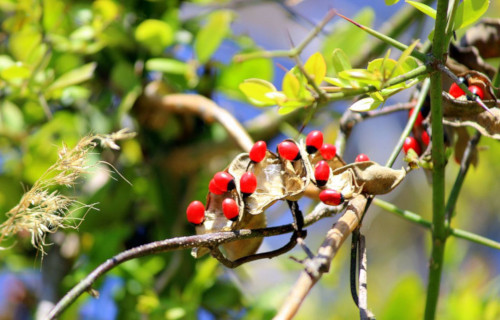
CCL: https://bit.ly/2wf1CQJ
Rosary Pea Facts
- Heading up this listing of 5 Deceptively Dangerous Herbaceous Plants is one that may astonish many people, the Rosary Pea.
- First of all, the term serves as the common name for an extremely remarkable variety of herbaceous flowering plant. Also known by the scientific name of the Abrus precatorious, this plant proves that beauty can conceal danger.
- That’s due to the fact that the plant holds a dark secret. This innocent-seeming plant actually contains high quantities of a chemical compound called abrin. This chemical holds a very close relationship with the incredibly deadly chemical, risin.
- In point of fact, the consumption of even a single berry can prove fatal to an average-sized human being. Quite incredibly, despite this fact, the colorful berries of this particular flora have long been used by man for many purposes.
- Ironically, these ultra-deadly small fruits were long used for an astonishing purpose, given their toxicity. These formed the original source of the rosary beads used in worship. That, therefore, formed the basis of the common name for the deadly plant.
- For the moment, the remarkable Rosary Pea appears to have a stable population. Further, this fortunate situation seems to hold true throughout the entirety of its native range. As a result, the IUCN currently has no listing for it.
- Nevertheless, the lovely but dangerous plant likely faces several threats to its continued existence. Like many species today, these likely include the danger of habitat loss. But its greatest threat most likely consists of climate change.
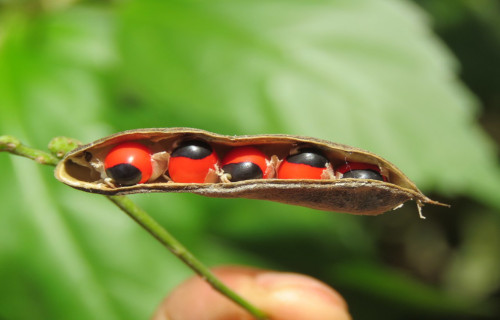
CCL: https://bit.ly/34dpBfF
Rosary Pea Physical Description
Firstly, botanists categorize the Rosary Pea as a legume. This occurs because this perennial plant develops in the form of a slender, climbing vine. In addition, the species frequently twists its way around trees, hedges, and shrubs.
Secondly, its leaves develop as quite slender, and roughly 5 in (12.7 cm) long. Further, the thin branches develop as herbaceous in nature. The flowers remain small and show either white, violet, or pink, and typically grow densely clustered.
Thirdly, the deadly seeds of the fascinating plant develop within small pods. These average roughly 2 in (5.1 cm) in length. Each pod contains 3-8 of the seeds, and thankfully, the shell of each produces a relatively thick and hard covering.
Finally, the seeds of the Rosary Pea themselves appear in different color varieties. However, the red color with a black spot remains the most common of the combinations. Nevertheless, white, green, and black seeds occur as well.
- Kingdom: Plantae
- Phylum: Angiosperm
- Class: Eudicots
- Order: Fabales
- Family: Fabaceae
- Genus: Abrus
- Species: A. precatorius
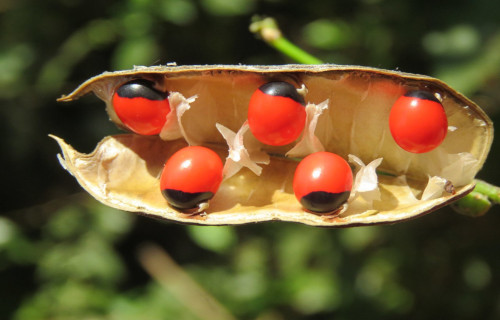
CCL: https://bit.ly/34dpBfF
Rosary Pea Distribution, Habitat, and Ecology
The remarkable Rosary Pea evolved as endemic to several continents. These include the regions of Asia, Africa, and Australia. However, this remarkably adaptable species has now been spread to most regions of the world with compatible climates.
These areas into which it has been artificially introduced include the Caribbean Islands, Belize, Hawaii. In addition, this also includes parts of that state of Florida, in the United States, in North America, as well as the country of India.
Although it did evolve as a highly adaptable species, the plant nevertheless has types of climate that it prefers. These primarily consist of regions of subtropical forests. Although it’s quite tolerant of most types of soil, it flourishes best where that soil is well-drained.
It most commonly spreads via the distribution of its numerous seeds. These seeds, created in vast numbers, remain viable for an entire year. Due to this aggressive nature, in these regions, people generally consider the Rosary Pea an invasive species.
That’s true because it has proven to be extremely adaptable, and difficult to eradicate in these areas. This occurs partly because its roots grow extremely deep and nearly impossible to remove. In fact, burning, intentional or otherwise, actually encourages it to grow.
Texas Bluebonnet
Texas Bluebonnet Facts
- Our next entry in this compendium of 5 Deceptively Dangerous Herbaceous Plants is the seemingly delicate Texas Bluebonnet.
- First of all, the highly distinctive name of the flora serves as one of the common names of a seemingly delicately beautiful plant. However, this wonderful marvel of Nature also goes by the alternate common name of the Texas lupine.
- Furthermore, it also possesses the slightly complex scientific name of the Lupinus texensis. By either name, though, its remains a deceptively sturdy species. This fantastic plant also typically presents in only its base form.
- However, in recent years, this has begun to change within its naturally occurring populations. That holds true due to the surprising fact that isolated mutations of the beautiful plant have recently begun to appear in scattered portions of its range.
- For the moment, at least, botanists remain at a loss for an explanation for this. Regardless of this, though, the state of Texas officially recognizes both the original species of the flower, and all mutations of it, as the state flower.
- Despite the limitations of its range, it appears to be maintaining a stable population base. Therefore, the IUCN currently lists it as Least Concern. But, it must be considered to be at some risk. Like many species, its greatest threat comes from climate change.
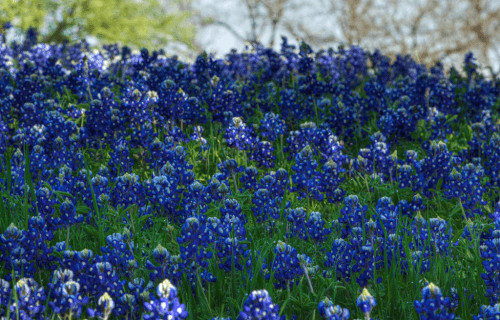
CCL: https://bit.ly/1ryPA8o
Texas Bluebonnet Physical Description
The truly stunning Texas Bluebonnet boasts several physiological characteristics that make it worthy of note. Firstly, the plant has quite humble beginnings. That holds true due to the fact that this gorgeous plant begins its life as an extremely tiny seed.
Secondly, that tiny source of life also has an extremely tough outer layer. It remains so tough that it often takes months, or even years for the weather to erode the outer layer. This means that germination quite often never has the chance to occur, depending on weather.
Once germinated, however, the tiny seedling of the species most commonly appears in the Fall. Furthermore, the stunning plant evolved as a biennial species. In addition, the plant grows slowly during the winter and does not attain full growth until the onset of Spring.
But, once the gorgeous flora does reach its full growth, the flower typically reaches a maximum height measuring around 24 in (60 cm). In addition to its size, the magnificent Texas Bluebonnet presents a striking visual image to those who encounter it.
In point of fact, the individual specimens boast some stunning colors. Individuals plants primarily develop as dark blue in color. But, although rare, variations in this basic pattern do occur. Further, the colors of these isolated mutations include pink, maroon, and white.
- Kingdom: Plantae
- Phylum: Angiosperms
- Class: Eudicots
- Order: Fabales
- Family: Fabaceae
- Genus: Lupinus
- Species: L. texensis
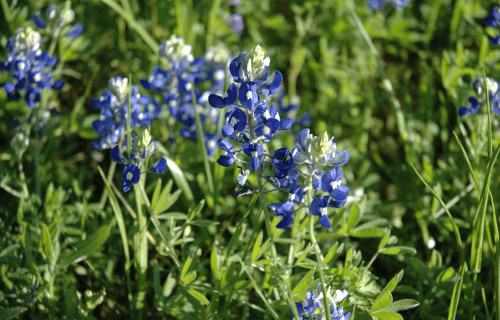
CCL: https://bit.ly/1ryPA8o
Texas Bluebonnet Distribution, Habitat, and Ecology
Unfortunately for those who appreciate its beauty, the Texas Bluebonnet only inhabits a small section of the globe. It only lives in a small portion of the continent of North America. More specifically, though, it mainly appears in the state of Texas, in the United States.
Nevertheless, it also appears in smaller, widely scattered populations in the states of Florida, Oklahoma, and Louisiana. Furthermore, even within this highly restricted range of habitation, it shows decided preferences for the regions it inhabits.
In point of fact, and surprisingly, these generally constitute relatively inhospitable regions. The species most often prefers loose, often rocky soil. The truly beautiful flower also commonly grows in uncultivated areas, including prairies, and along roadsides.
In addition, the beautiful Texas Bluebonnet most typically grows in areas of direct sunlight. Here, its dazzling color scheme creates a visually dynamic effect to observe. However, its beauty, as is often the case in Nature, conceals a dangerous attribute.
That holds true due to the fact that this delicate wildflower also lists as moderately toxic. But, it does not generally pose a threat to humans unless ingested. Meanwhile, the Angiosperm also serves as an important food source for several butterflies.
Lotus Corniculatus
Lotus Corniculatus Facts
- Placing third among our choices of 5 Deceptively Dangerous Herbaceous Plants, but only due to random selection, comes the Lotus Corniculatus.
- That term serves as the scientific name of a stunning and extremely unusual small flowering plant. It also goes by several common names. These include the birdsfoot deervetch, and even the comical sounding eggs and bacon.
- But, regardless of the name one uses for it, the gorgeous plant remains a true marvel of Nature. This actually holds true for reasons other than just its beauty. Believe it or not, the stunning species actually constitutes a member of the pea family.
- However, you do not want to eat it, regardless of its remarkable visual appeal. That’s due to an astonishing fact. That’s the fact that this little beauty actually contains naturally occurring trace amounts of the deadly chemical cyanide.
- In extremely small amounts, however, this beautiful and remarkable species does have some medicinal uses. To the great surprise of many people, though, the beautiful plant also actually gets widely used as a source of forage for livestock.
- The majority of animal kept as livestock, fortunately for them, have an advantage over human beings. That’s true since many of these animals can eat the beautiful yet dangerous Lotus Corniculatus without incurring any harmful effects.
- Most animals have a much greater natural tolerance for small concentrations of cyanide than homo sapiens. Fortunately, the lovely flora also has a comparatively wide range of distribution. Therefore, the IUCN has no listing for it.

CCL: http://bit.ly/2GGxvUT
Lotus Corniculatus Physical Description
Most notably, though seemingly extremely delicate, the magnificent Lotus Corniculatus surprises most people. That’s due to the fact that this particular variety of Angiosperm holds many surprises. Among those is the fact that it’s actually quite hardy.
Nonetheless, sheer physical size does not rank as one of the astounding characteristics of the beautiful Angiosperm. That remains true since this herbaceous plant only achieves a maximum known height of about 8 in (20 cm) unless supported by other plants.
Further, this stunning flora most commonly grows in a sprawling manner along the ground. But it rarely does so over great distances. In addition, the small flowers of the gorgeous Lotus Corniculatus display combinations of orange and yellow color.
Also, and not surprisingly, since it is part of the pea family, the seeds develop in small, elongated pods. Furthermore, the leaves of the plant most commonly grow in groups of five. Typically, three of these form a trefoil pattern over the other two.
- Kingdom: Plantae
- Phylum: Angiosperms
- Class: Eudicots
- Order: Fabales
- Family: Fabaceae
- Genus: Lotus
- Species: L. corniculatus
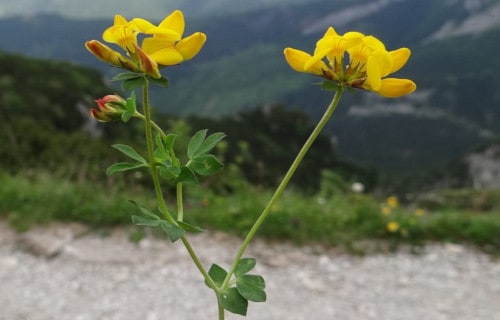
CCL: http://bit.ly/2P4R3Ic
Lotus Corniculatus Distribution, Habitat, and Ecology
First of all, the visually breathtaking, and scientifically fascinating, Lotus Corniculatus remains endemic to a remarkably large section of the globe. In point of fact, the plant inhabits a wide swathe of the continents of Europe, Asia, and Northern Africa.
Furthermore, within that truly impressive geographical range of habitation, the plant also predominantly appears in regions of grasslands. But, regardless of its habitat, this marvelous species of flora qualifies as far more than just another visually appealing creation of Nature.
This particular Angiosperm also has an incredibly extreme level of durability. This holds true even to the point of surviving being trampled by livestock. In addition, this unexpectedly tough species also grows equally well in both nutrient-rich soils and nutrient-poor soils.
Further, the Lotus Corniculatus most commonly grows in areas that most plants would find forbidding. In point of fact, this primarily consists of regions of grassland with a high percentage of sand. Few species with comparable beauty can make this claim.
Due to its hardiness, farmers often actually use it in cultivation, especially in certain parts of Europe. Finally, as a result of this practice, it has become considered an invasive species in some portions of Australia and North America.
Dwarf Crested Iris
Dwarf Crested Iris Facts
- Next up in this compendium of 5 Deceptively dangerous Herbaceous Plants comes the beautiful yet potentially dangerous Dawrf Crested Iris.
- The somewhat descriptive term for this marvel serves as the most frequently used of the common names for this beautiful plant species. The delicate marvel also goes another, closely related common name. That’s the simpler term of the crested iris.
- The official scientific name for this creation of Nature and evolution is the comparatively simple term of Iris cristata. Regardless of which term one use to refer to it, however, one fact remains consistent. That’s the fact that, while gorgeous, it’s tiny.
- Though not the first to note it, the Scottish botanist, William Aiton holds the distinction of making the first official recognition of the plant as a separate and distinct species. This scientifically noteable feat the renowned researcher accomplished in 1789.
- Though it had long been known to the Indigenous Peoples of its native region, the American botanist John Bartram became the first European botanist to notice it. In the 1750’s, he sent several specimens to England. It’s been present there since 1776.
- For the moment, the IUCN has no listing for the Dwarf Crested Iris. Any such listing would appear on the organization’s published Red List of Threatened Species. This occurs both due to its numbers in the wild, as well as in global cultivation.
- It nevertheless facing some potential threats. Due to this, it’s listed as Endangered is a few parts of its native range. Habitat loss naturally represents one of the dangers it faces. Its greatest threat, though, most likely comes in the form of climate change.
Dwarf Crested Iris Physical Description
The delicate beauty of the Dwarf Crested Iris certainly merits attention from those who encounter it, of course. That aspect of its biology, however, manifests despite what some might think a disadvantage. That’s due to the fact that this marvel stands quite short.
More precisely, the perennial plant packs all of its outstanding beauty in a package that only attains a maximum height of around 6 in (15 cm). An average height for this floral variety, however, measures about 4 in (10 cm). Some specimens do not exceed 3 in (7.6 cm).
The iris variety also produces numerous long, slender leaves, which present a moderately deep green color. This rather distinctive foliage further develops in a highly variable length. These leaves extend outward in lengths ranging from 4 – 16 in (10 – 40.6 in).
Each plant typically produces a single bloom, though two develop on rare occasions. Remarkably, the petals of these tiny, delicate blooms develop in a wide variety of shades. Its sepals, meanwhile, have a white or yellow, central band, with a purple stripe.
Of further note is the extreme range of the shades the petals of the Dwarf Crested Iris manifest. These, in facct, develop across the spectrum lying between blue to purple to white. This range further varies from individual plant to plant, with no apparent pattern.
- Kingdom: Plantae
- Phylum: Angiosperms
- Class: Monocots
- Order: Asparagales
- Family: Iridaceae
- Genus: Iris
- Species: I. cristata
Dwarf Crested Iris Distribution, Habitat, and Ecology
Unfortunately for those who appreciate its beauty in the wild, the Dwarf Crested Iris possesses a somewhat limited native range of distribution. That’s due to the fact that the diminutive beauty appears naturally in only a small portion of the Northern Hemisphere.
That range of habitation covers portions of a total of nineteen states in the United States, in North America. These states appear in the northeastern, north-central, and southeastern portions of the country. Evidence further indicates it never spread elsewhere.
Somewhat surprisingly, this tiny Angiosperm evolved as endemic to soil containing relatively high ratios of lime. Given this, the plant most often appears naturally in areas such as rocky hillsides, ravines, oak woodlands, mountain ledges, and along gentle streams.
These regions, however, also need to meet yet another condition for the plant to thrive. These conditions must include the specific site to be well drained. If excessive moisture remains in the local soil, the species does poorly, severely limiting its potential expansion.
Pollination of the Dwarf Crested Iris principally occurs due to the activities of several types of bees. Several varities of hummingbirds, though, also favor the flowering plant, finding its nectar especially appealing. In cultivation, it also reproduces via root division.
It further prefers areas of cool, partially shaded conditions, but also does reasonably well in direct sunlight. Its magnificent flowers typically appear in early Spring. Afterward, the plant most frequently goes dormant during the local Winter season.
Local Native American populations, especially the Cherokee, have long used it in traditional medicines. Caution must nevertheless be taken with the little beauty. That’s because, like related species, many parts of this wonder of evolution are moderately poisonous.
Giant Hogweed
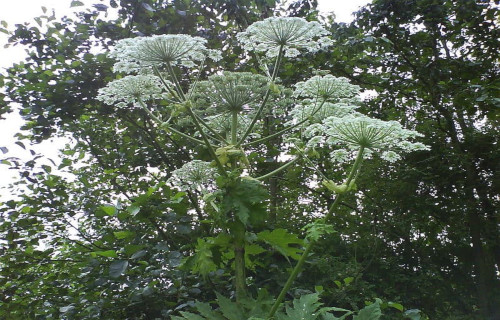
CCL: https://bit.ly/1jxQJMa
Giant Hogweed Facts
- The fifth and final entry into our compendium of 5 Deceptively Dangerous Herbaceous Plants is the incredible Giant Hogweed.
- Perhaps most notably, the astonishing plant known as the Giant Hogweed hides a truly dark secret. The unassuming plant remain quite poisonous. In fact, the innocent looking species actually ranks as one of the most dangerous plants on earth.
- This apparently bizarre fact occurs because of the nature of the naturally occurring sap of the remarkable plant. This ever-present liquid component of the flora evolved quite astonishingly powerful phototoxic properties.
- Not only that, but it’s produced by the plant in extremely copious quantities. Therefore, once on the skin, this powerful natural chemical causes extraordinary amount of damage to human skin. It frequently creates extreme blisters.
- These blisters can also generate severe scarring when exposed to light. Unfortunately, these terrible effects are not short-lived. To the horror of those exposed to it, in some individuals, these scars can last for months, or even years.
- Finally, one more factor makes the Giant Hogweed potentially severely dangerous. Its danger becomes compounded by its strong resemblance to another, harmless plant. This is the Queen Ann’s Lace, a popular ornamental plant.
Giant Hogweed Physical Description
Firstly, the Giant Hogweed typically grows to an amazing height. This vertical growth typically measures between 6.5 ft and 16.5 ft (2 – 5 m), itself an impressive measurement. But, under ideal conditions, the plant has the ability to grow as tall as 18 ft (5.5 m).
Secondly, a grown plant also produces numerous, large leaves. Further, these sometimes have a width of as much as 5 ft (1.5 m). Also, these grow from a strong, thick stem. This develops colored bright green. The leaves also have dark blotches and rough white hairs.
The large, umbrella-shaped head of this surprising plant boasts another astonishing dimension. The head, or crown, can measure as much as 39 in (1 m) across. In addition, the usually relatively thick stems these grow from also contain the thick, highly dangerous sap.
The flowers of the Giant Hogweed generally develop as small. Nonetheless, they also appear in copious numbers. These small but numerous blooms usually show either white or greenish-white in color. The fruits produce large dry seeds that average 0.4 in (1 cm).
- Kingdom: Plantae
- Phylum: Angiosperms
- Class: Eudicots
- Order: Apiales
- Family: Apiaceae
- Genus: Heracleum
- Species: H. mantegazzianum
Giant Hogweed Distribution, Habitat, and Ecology
First of all, the highly prolific Giant Hogweed evolved as native to the Caucasus Mountains, located in Russia. However, the startling species quickly spread to a remarkably wide swathe of western and northern sections of Europe.
Later, it also spread to the countries of Canada and the United States, in North America. There, it quite understandably remains considered an invasive species in many regions. It further displays a remarkable ability to adapt to varied habitats.
However, the remarkable variety of flora primarily thrives in certain, specific types of areas. Therefore, it’s concentrations appear greatest in such regions of the areas it inhabits as coastal areas, along river banks, and in temperate forests.
The plant requires several years of growth before it produces seeds. But, once the Giant Hogweed does, it commonly creates them in vast numbers. In fact, each individual plant typically produces in excess of 20,000 seeds, assuring its ability to spread rapidly.
It’s not just the effects of contact with its sap that serves as the source of what makes it dangerous. The danger is augmented by the speed of its effects. The symptoms typically appear within 15 minutes of contact with the skin and exposure to light. Then, a rash appears.
But this persistent and rapidly-spreading rash can also become quite severe, leaving acid-like burns on the skin. Just a minimum contact with the eyes can cause permanent blindness. Finally, extensive exposure, even just to the skin, can prove fatal in some instances.
5 Deceptively Dangerous Herbaceous Plants
We sincerely hope that you have thoroughly enjoyed this article about 5 Deceptively Dangerous Herbaceous Plants. Countless examples of this principle fill the natural world. However,many of these incredible species now find themselves facing the danger of extinction. It remains up to each of us to do all that we can to protect and preserve them for our posterity.
Check out our other articles on Earth’s Many Magnificent Marsupials, Astounding Lizards of the World, Sensational Spiders Around the World, 5 Fabulous Deer Varieties
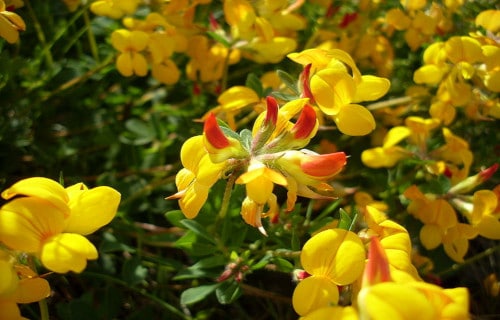
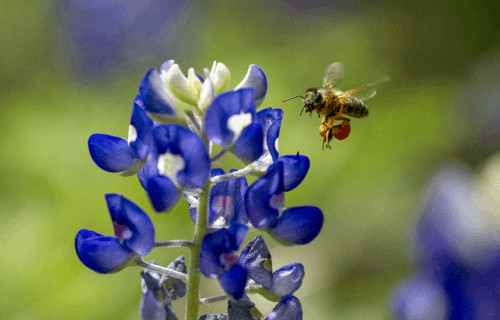
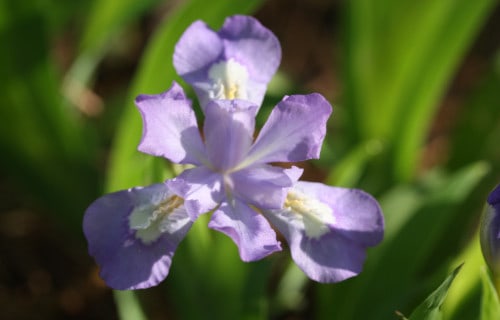
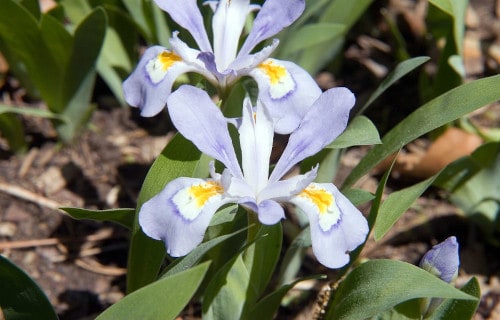
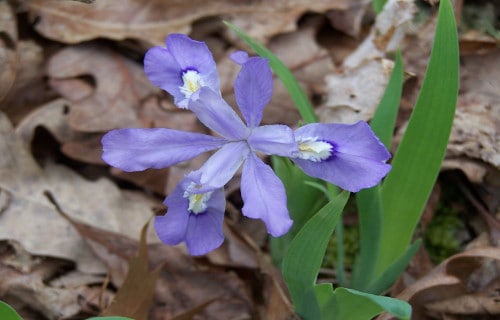

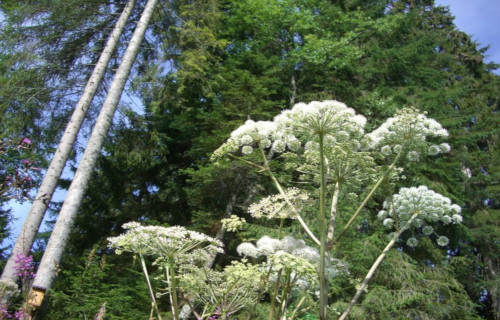









Leave a Reply